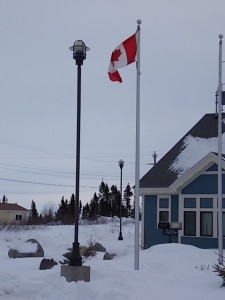
Maple Leaf Flag outside new RCMP (police) building in Innu village of Sheshatshiu. The Innu word on the RCMP sign means
`The house of the people who grab you.`
Photo Anthony Jenkinson.
Canada’s National Flag Day (15th February) is a good time to consider what this nation itself might mean to the men and women whose ancestors knew no flags. The maple leaf is of course an emblem that identifies something called ‘Canada,’ a state, society, landscape, ethos and multiple institutions with which millions of Canadians proudly identify themselves. It is the symbol of a settler state, a state that was fashioned from colonialism.
Britain and France claimed the lands, and now Canada asserts dominion over territories where indigenous peoples were, until recently, self-sufficient and independent. This flag like all flags has no singular meaning. To some ‘Canada’ might be associated with the warmth of human connection, of people identifying themselves as part of a large and unique community within a world of nation-states, but to others it represents loss of autonomy, identity and connection.
One rarely examined method, by which the Canadian government affirms its version of the national narrative, is through the Comprehensive Land Claims (CLC) system. On the surface, CLC appears a magnanimous gesture to recognise the rights of those upon whose lands the state is built. Through it aboriginal groups who have not signed any treaty or agreement, are offered terms by which they can surrender their lands in exchange for rights. The Innu Nation of Northern Labrador is currently in the final stages of negotiating the Tshash Petapen CLC agreement.
In it, the parameters of what can be ‘claimed’, even the status, political formation and funding of the indigenous political body doing the negotiating, are internal to the state itself. The proving of the claim can only occur in tandem with indigenous ownership of land (known as ‘Aboriginal Title’) being directly or indirectly extinguished.
In this Kafkaesque process, the signed land claim agreement is the eligibility criterion for handing over ownership of lands to Canada. In this case, the Innu Nation will also be made party to the unilateral extinguishment of the rights of other Innu in Quebec whose lands they share in Labrador.
Although all land claims agreements in Canada have radically reduced aboriginal land bases, there are some benefits to the claimants. Groups like the Innu Nation, configured by the government for the purposes of negotiation, obtain limited rights to self-government, hunting and fishing in defined territories and cash compensation. However, these rights are really just lesser versions of what they formerly enjoyed as independent peoples. In the case of Tshash Petapen, the agreement is contingent upon the Innu also agreeing to permit a massive environmentally damaging hydroelectric power project at Muskrat Falls and Gull Island on the vast Mista-shipu River in the heart of Innu territory.

Muskrat Falls, 7 July 2013 showing construction work proceeding before the final agreement to legitimate it. Photo by Anthony Jenkinson
These lands are construed as Crown Land by fiat, making Innu consent superfluous, yet they are lands occupied by all Innu well before the appearance of any European. Although the final approval of Tshash Petapen and the hydro agreement are both required to trigger the final agreement, construction on the site is already well advanced. Financial benefits accrue to both ‘Innu businesses’ and the Innu Nation, but this is simply recompense for a fait accompli.
Few people know the details of this efficient bureaucratic operation. CLC completes the dispossession of indigenous peoples. It makes the maple leaf an enduring symbol of colonialism.
Further information:
Colin Samson’s A World You Do Not Know: Settler Societies, Indigenous Peoples and the Attack on Cultural Diversity, for more detail and analysis of Canadian Land Claims generally, focusing specifically on the Tshash Petapen agreements, especially chapters 3 and 4
Colin Samson is the Director of BA Humanities at the University of Essex. Colin has recently completed a book which examines the intellectual architecture and practices of settler societies that justified an attack on the cultural diverse ideas and practices of indigenous peoples. Based partly on ethnographic fieldwork in Innu hunting camps in Northern Canada, the book also looks at contemporary efforts by indigenous groups to reverse some of the more damaging aspects of colonialism through cultural revitalisation projects. The book is entitled A World You Do Not Know: Settler Societies, Indigenous Peoples and the Attack on Human Diversity and is to be the first in the Critical Human Rights Series of the University of London Press.
